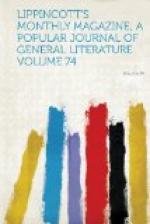The fashion of so-called historical dramas is spreading, but the standard is lowering. When Mr. Swinburne wrote Chastelard, whatever its faults, it was entitled to the name of drama: last year he published Bothwell, which, whatever its beauties, does not deserve to be so ranked. Tennyson’s Queen Mary followed during the past summer, and many similar attempts may be expected from less illustrious pens. It is an unfortunate direction for dramatic and poetic composition to have taken, tending to impair the excellence of both styles, while fulfilling the exigencies of neither. Bothwell and Queen Mary are not historical dramas, but versified chronicles, a certain number of pages of the annals of Scotland and England in metre, divided into acts and scenes and distributed into parts. Such a production, be it called what it may, must necessarily lack the essential qualities of the true drama, while it introduces into a branch of literature which belongs to the imagination the realism against which art is struggling. The latest specimen of this new school is Mr. Story’s Nero, for, although by his preface it appears that the publication did not follow the writing for several years, it comes to the world in the wake of the aforementioned works. It is to be remembered that Mr. Story’s pen is as versatile as his talent is various. He has given the public two law-books, commonly attributed to his eminent father; the delightful Roba di Roma, which embodies the actual animate beauty and interest of Roman life; a volume of poems, Graffiti d’Italia, full of fine dramatic fragments and studies of character in the manner of Browning, descriptions which are pictures, and sweet verses which live in the heart; and a number of essays in the pleasantest style of table-talk. Moreover, we are to bear in mind that this gentleman is not an author by profession, but one of the most distinguished living sculptors. But the very merit of his productions subjects them to a code of criticism more severe than that by which amateur performances are usually judged, and the faults one finds are by comparison with a standard which makes fault-finding flattery. In the first place, one cannot turn over a few pages of Mr. Story’s Nero without perceiving that he is imbued with the knowledge of classical things and times, and with the study of Shakespeare and the old English playwrights. The turn of the phrases and the march of the passages recall those best models, though without imitation. As in them, there is less beauty than vigor and spirit: the dialogue is strewn with expressions as striking as they are simple. Speaking of Claudius’s murder, Burrhus says:
And Agrippina, startled, pushed him
down
The dark declivity to death.
Agrippina herself to Nero:
Oh
what a day it was
When, with a shout that seemed to rend
the air,
The army hailed you Caesar! My poor
heart
Shook like the standards straining to
the breeze
With that great cheer of triumph.




